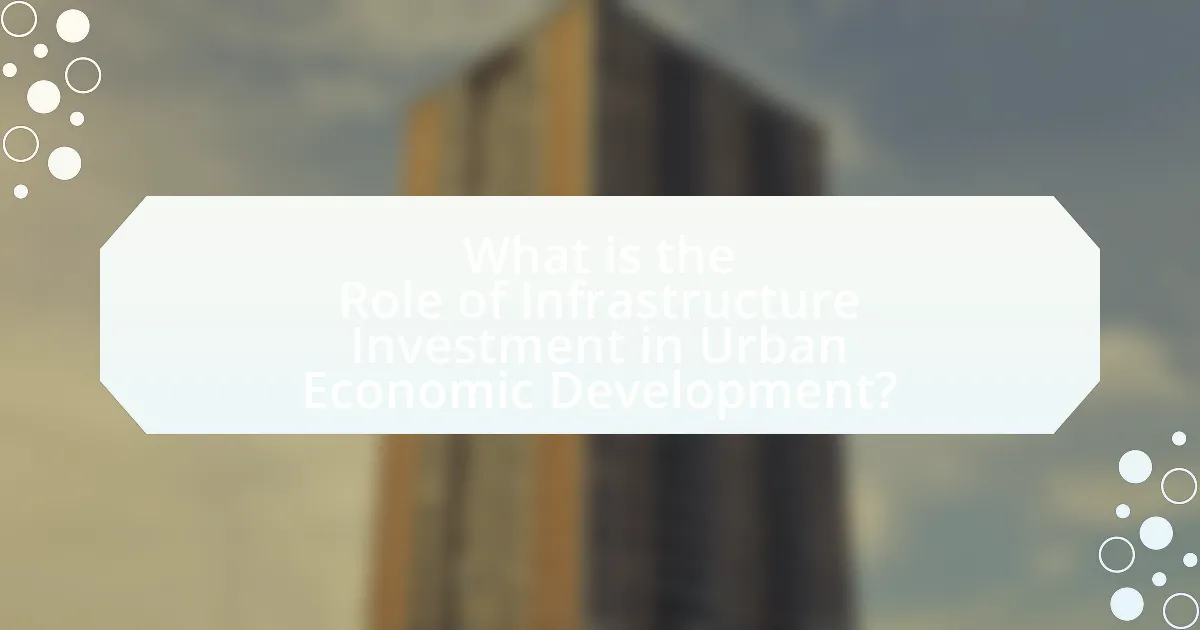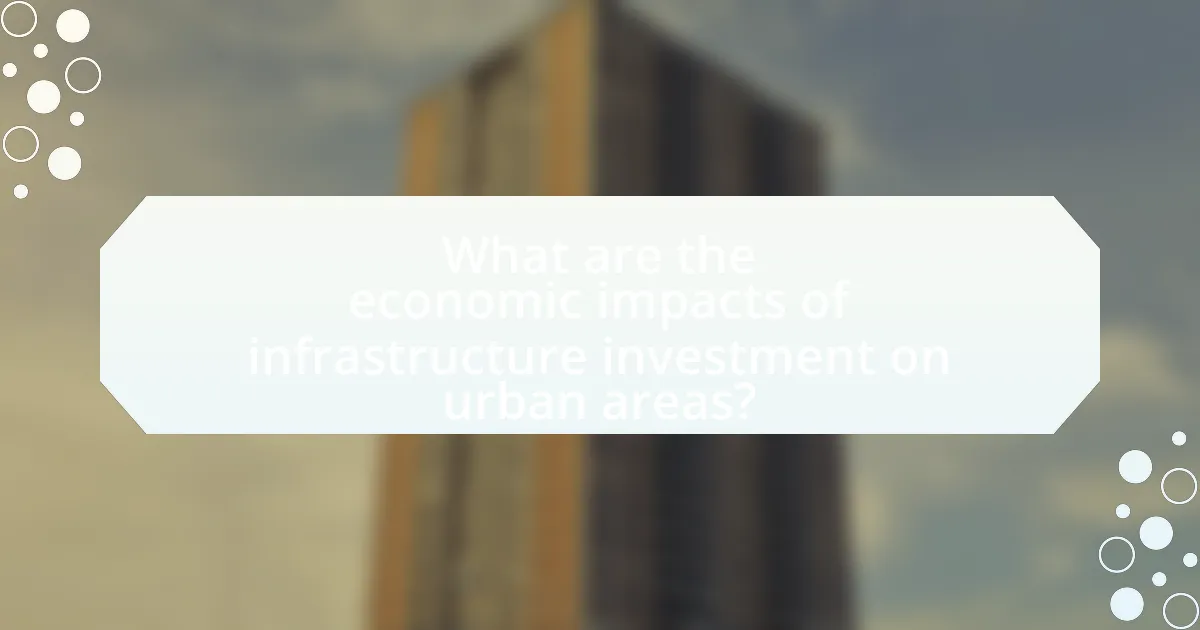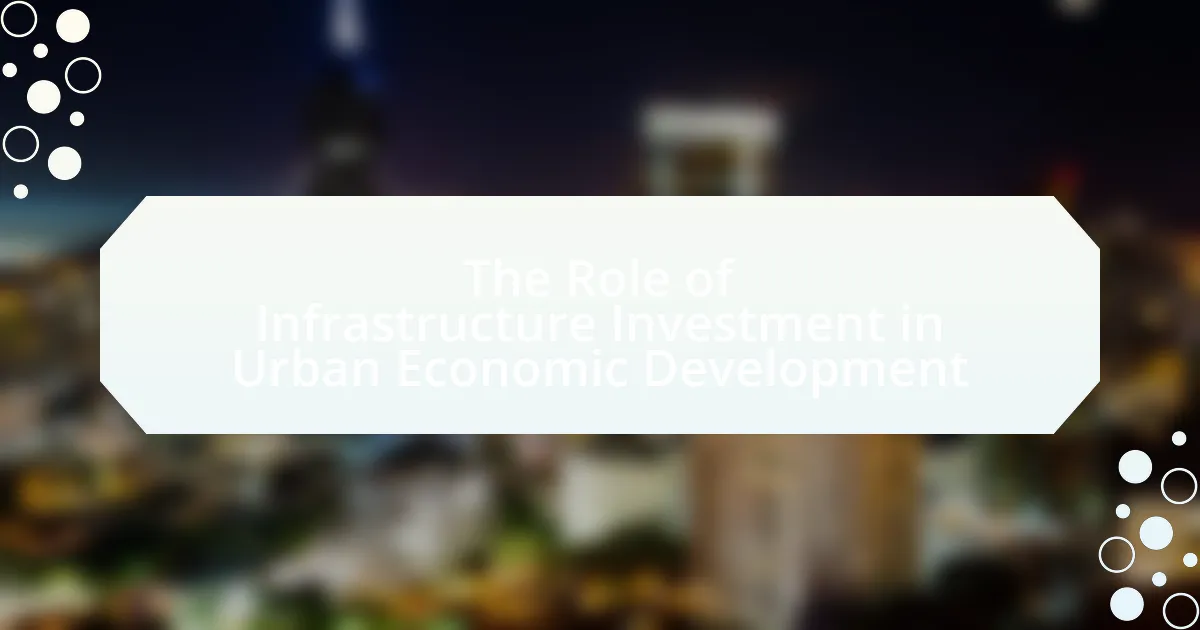Infrastructure investment is a critical component of urban economic development, significantly enhancing connectivity, improving public services, and attracting businesses. The article explores how effective infrastructure, particularly transportation and utilities, drives economic growth by facilitating the movement of goods and people, reducing operational costs, and creating jobs. It highlights the long-term benefits of infrastructure investment, including increased property values and improved quality of life, while also addressing challenges such as funding constraints and community opposition. Additionally, the article discusses the importance of strategic planning, stakeholder engagement, and public-private partnerships in maximizing the impact of infrastructure investments on urban economies.

What is the Role of Infrastructure Investment in Urban Economic Development?
Infrastructure investment plays a crucial role in urban economic development by enhancing connectivity, improving public services, and attracting businesses. Effective infrastructure, such as transportation networks, utilities, and communication systems, facilitates the movement of goods and people, which is essential for economic activities. For instance, a study by the World Bank indicates that every 1% increase in infrastructure investment can lead to a 0.1% increase in GDP growth. Additionally, well-developed infrastructure can reduce operational costs for businesses, making urban areas more competitive and appealing for investment. This correlation between infrastructure and economic performance underscores the importance of strategic investment in urban settings.
How does infrastructure investment influence urban economies?
Infrastructure investment significantly enhances urban economies by improving connectivity, increasing productivity, and attracting businesses. For instance, investments in transportation systems, such as roads and public transit, reduce travel time and costs, facilitating the movement of goods and people. This efficiency leads to higher economic output; a study by the American Society of Civil Engineers found that every dollar invested in public infrastructure generates approximately $3.70 in economic returns. Additionally, improved infrastructure can attract new businesses and residents, as seen in cities like Atlanta, where infrastructure upgrades have spurred economic growth and job creation. Thus, infrastructure investment is a critical driver of urban economic development, fostering a more competitive and sustainable economic environment.
What types of infrastructure are most impactful in urban settings?
Transportation infrastructure, including roads, public transit systems, and airports, is the most impactful type of infrastructure in urban settings. Effective transportation networks facilitate the movement of people and goods, which is essential for economic activity. For example, cities with well-developed public transit systems, such as New York and Tokyo, experience higher levels of accessibility and economic productivity, as evidenced by studies showing that public transit can increase local employment rates by up to 20%. Additionally, utilities infrastructure, such as water supply and energy systems, plays a critical role in supporting urban life and economic growth, with reliable services being linked to improved public health and increased business operations.
How does infrastructure investment affect job creation in cities?
Infrastructure investment significantly boosts job creation in cities by enhancing connectivity and stimulating economic activity. When cities invest in infrastructure such as roads, bridges, and public transit, they create immediate construction jobs and long-term employment opportunities in various sectors. For instance, a study by the American Society of Civil Engineers found that every $1 billion invested in infrastructure generates approximately 13,000 to 19,000 jobs. Additionally, improved infrastructure attracts businesses, leading to further job creation as companies expand or relocate to areas with better access to transportation and utilities. This cycle of investment and job growth underscores the critical role infrastructure plays in urban economic development.
Why is infrastructure investment critical for urban growth?
Infrastructure investment is critical for urban growth because it enhances connectivity, supports economic activities, and improves quality of life. Well-developed infrastructure, such as transportation systems, utilities, and communication networks, facilitates the movement of goods and people, which is essential for businesses to thrive. For instance, cities with robust public transit systems experience higher economic productivity, as evidenced by a study from the American Public Transportation Association, which found that public transit generates approximately $4 in economic returns for every $1 invested. Additionally, infrastructure investment attracts private investment, leading to job creation and increased tax revenues, further fueling urban development.
What are the long-term benefits of investing in urban infrastructure?
Investing in urban infrastructure yields long-term benefits such as enhanced economic growth, improved public health, and increased property values. Enhanced economic growth occurs as infrastructure facilitates efficient transportation and connectivity, leading to increased business activity; for instance, a study by the American Society of Civil Engineers found that every dollar invested in infrastructure generates approximately $3.70 in economic returns. Improved public health results from better access to clean water, sanitation, and transportation, which can reduce healthcare costs and increase productivity; the World Health Organization reports that investments in water and sanitation can yield a return of $4.30 for every dollar spent. Increased property values are driven by well-maintained infrastructure, as neighborhoods with better roads, parks, and public services tend to attract higher demand, evidenced by a report from the National Association of Realtors indicating that homes near quality infrastructure appreciate faster than those without.
How does infrastructure investment enhance the quality of life in urban areas?
Infrastructure investment enhances the quality of life in urban areas by improving access to essential services, reducing travel times, and fostering economic growth. For instance, the development of public transportation systems allows residents to commute more efficiently, which can lead to increased job opportunities and reduced traffic congestion. According to a study by the American Public Transportation Association, every $1 invested in public transit generates approximately $4 in economic returns, demonstrating the direct correlation between infrastructure investment and economic vitality. Additionally, improved infrastructure, such as roads, bridges, and utilities, contributes to better health outcomes by providing reliable access to healthcare facilities and clean water, further elevating the overall quality of life for urban residents.
What challenges are associated with infrastructure investment in urban development?
Infrastructure investment in urban development faces several challenges, including funding constraints, regulatory hurdles, and community opposition. Funding constraints arise from limited public budgets and the need for private investment, which can lead to delays or scaled-back projects. Regulatory hurdles often involve complex permitting processes and compliance with various local, state, and federal regulations, which can slow down project timelines. Community opposition can stem from concerns about displacement, environmental impacts, or changes to neighborhood character, making it difficult to gain public support for new infrastructure initiatives. These challenges can significantly hinder the effectiveness and efficiency of infrastructure investments in urban areas.
What financial barriers do cities face in funding infrastructure projects?
Cities face significant financial barriers in funding infrastructure projects, primarily due to limited budgets, reliance on fluctuating tax revenues, and high levels of existing debt. Limited budgets restrict the amount of capital available for new projects, while tax revenues can be unpredictable, especially during economic downturns, leading to insufficient funds for necessary infrastructure improvements. Additionally, many cities operate under high debt levels, which can limit their ability to borrow further for new projects. According to the National League of Cities, nearly 70% of cities report that funding constraints are a major barrier to infrastructure investment, highlighting the critical nature of these financial challenges.
How do political factors influence infrastructure investment decisions?
Political factors significantly influence infrastructure investment decisions by shaping policy frameworks, funding availability, and regulatory environments. Governments prioritize infrastructure projects based on political agendas, which can lead to increased funding for certain initiatives while neglecting others. For instance, political stability often attracts foreign investment, as seen in countries like Singapore, where consistent governance has led to substantial infrastructure development. Additionally, political ideologies can dictate the types of infrastructure prioritized, such as renewable energy projects under environmentally focused administrations. Historical data shows that regions with strong political support for infrastructure tend to experience faster economic growth, as evidenced by the rapid urban development in cities like Dubai, driven by government-led initiatives.
How can cities effectively prioritize infrastructure investments?
Cities can effectively prioritize infrastructure investments by utilizing data-driven assessments to identify critical needs and potential economic impacts. This approach involves analyzing factors such as population growth, traffic patterns, and existing infrastructure conditions to determine where investments will yield the highest returns. For instance, a study by the American Society of Civil Engineers indicates that every dollar invested in infrastructure generates approximately $3.70 in economic returns, highlighting the importance of strategic prioritization. Additionally, engaging community stakeholders in the decision-making process ensures that investments align with public needs and preferences, further enhancing the effectiveness of infrastructure spending.
What strategies can be employed to maximize the impact of infrastructure investment?
To maximize the impact of infrastructure investment, strategic planning and stakeholder engagement are essential. Strategic planning involves identifying key infrastructure needs that align with urban development goals, ensuring that investments address critical areas such as transportation, utilities, and public spaces. Stakeholder engagement includes collaboration with local communities, businesses, and government entities to gather input and foster support, which can lead to more effective and widely accepted projects.
Evidence from the World Bank indicates that well-planned infrastructure investments can yield economic returns of up to 30% in developing regions, demonstrating the importance of aligning projects with local needs and priorities. Additionally, the National Bureau of Economic Research highlights that infrastructure projects that incorporate community feedback tend to experience higher usage rates and better long-term sustainability.

What are the economic impacts of infrastructure investment on urban areas?
Infrastructure investment significantly boosts economic growth in urban areas by enhancing connectivity, increasing property values, and attracting businesses. Improved transportation networks, such as roads and public transit, facilitate the movement of goods and people, leading to increased productivity. For instance, a study by the National Bureau of Economic Research found that every $1 billion invested in infrastructure creates approximately 13,000 jobs and generates $3.7 billion in economic output. Additionally, upgraded infrastructure can lead to higher property values; a report from the Urban Land Institute indicated that properties near improved transit lines can see value increases of 20% or more. Furthermore, cities that invest in infrastructure often experience a surge in business investments, as companies seek locations with reliable services and accessibility, contributing to job creation and economic diversification.
How does infrastructure investment stimulate local businesses?
Infrastructure investment stimulates local businesses by enhancing accessibility, reducing operational costs, and fostering economic growth. Improved transportation networks, such as roads and public transit, enable easier movement of goods and customers, which directly increases sales opportunities for local businesses. For instance, a study by the National Bureau of Economic Research found that every $1 million invested in infrastructure can create approximately 13 jobs, leading to increased local spending and demand for services. Additionally, upgraded utilities and communication systems lower costs for businesses, allowing them to invest more in expansion and innovation. This combination of increased accessibility and reduced costs creates a favorable environment for local businesses to thrive.
What role does transportation infrastructure play in business growth?
Transportation infrastructure is crucial for business growth as it facilitates the movement of goods, services, and people, thereby enhancing market accessibility. Efficient transportation systems reduce logistics costs, improve delivery times, and expand customer reach, which are essential for competitive advantage. For instance, a study by the American Society of Civil Engineers indicates that every $1 billion invested in transportation infrastructure creates approximately 13,000 jobs and generates $1.5 billion in economic returns. This demonstrates that robust transportation networks not only support existing businesses but also attract new investments, fostering overall economic development in urban areas.
How does access to utilities affect economic development?
Access to utilities significantly enhances economic development by providing essential services that support business operations and improve quality of life. Reliable electricity, water, and sanitation services enable industries to function efficiently, attract investments, and create jobs. For instance, a study by the World Bank found that improved access to electricity can increase productivity in manufacturing sectors by up to 30%. Furthermore, access to clean water and sanitation is linked to better health outcomes, which in turn reduces healthcare costs and increases workforce productivity. These factors collectively contribute to a more robust and sustainable economic environment, demonstrating the critical role of utilities in fostering economic growth.
What is the relationship between infrastructure investment and property values?
Infrastructure investment positively influences property values by enhancing accessibility, improving local amenities, and stimulating economic growth. Studies indicate that areas with significant infrastructure improvements, such as transportation networks and public facilities, often see an increase in property demand and prices. For instance, a report by the National Bureau of Economic Research found that a 10% increase in public infrastructure investment can lead to a 1% to 2% rise in nearby property values. This correlation is attributed to the increased desirability of locations with better infrastructure, which attracts businesses and residents alike, thereby driving up real estate prices.
How do infrastructure improvements lead to increased property demand?
Infrastructure improvements lead to increased property demand by enhancing accessibility, connectivity, and overall quality of life in a given area. When transportation networks, utilities, and public services are upgraded, they make locations more attractive to potential buyers and investors. For instance, a study by the National Association of Realtors found that properties located near improved public transit systems can see value increases of up to 20%. Additionally, enhanced infrastructure often leads to economic growth, as businesses are more likely to invest in areas with reliable services, further driving up property demand.
What are the implications of infrastructure investment on housing affordability?
Infrastructure investment significantly impacts housing affordability by improving access to essential services and increasing property values. Enhanced infrastructure, such as transportation networks and utilities, often leads to higher demand for housing in well-connected areas, which can drive up prices. For instance, a study by the National Bureau of Economic Research found that a 10% increase in public transportation accessibility can raise property values by approximately 3-5%. This increase in demand can make housing less affordable for lower-income households, as they may be priced out of desirable locations. Therefore, while infrastructure investment can stimulate economic growth and development, it can also exacerbate housing affordability challenges in urban areas.
How does infrastructure investment contribute to sustainable urban development?
Infrastructure investment significantly contributes to sustainable urban development by enhancing connectivity, promoting efficient resource use, and supporting economic growth. Improved transportation systems, such as public transit and road networks, reduce congestion and lower greenhouse gas emissions, fostering a cleaner urban environment. Additionally, investments in renewable energy infrastructure, like solar and wind power, facilitate a transition to sustainable energy sources, decreasing reliance on fossil fuels. According to the Global Infrastructure Facility, every dollar invested in infrastructure can yield up to four dollars in economic returns, demonstrating the financial viability of such investments. Furthermore, sustainable infrastructure projects often incorporate green spaces and water management systems, which improve urban resilience against climate change impacts.
What role does green infrastructure play in urban economic development?
Green infrastructure significantly enhances urban economic development by improving environmental quality, increasing property values, and attracting businesses. Studies show that cities with robust green infrastructure, such as parks and green roofs, experience higher real estate prices; for instance, properties near parks can see value increases of up to 20%. Additionally, green infrastructure contributes to job creation in sectors like landscaping and environmental management, further stimulating local economies. By mitigating urban heat and managing stormwater, green infrastructure also reduces infrastructure costs, leading to more sustainable urban growth.
How can cities balance infrastructure investment with environmental concerns?
Cities can balance infrastructure investment with environmental concerns by adopting sustainable development practices that prioritize eco-friendly technologies and materials. For instance, integrating green infrastructure, such as permeable pavements and green roofs, can reduce urban runoff and improve air quality while supporting economic growth. Research from the American Society of Civil Engineers indicates that investing in sustainable infrastructure can yield a return of $4 for every $1 spent, demonstrating that environmentally conscious investments can also drive economic benefits. Additionally, cities can implement policies that require environmental impact assessments for new projects, ensuring that infrastructure development aligns with sustainability goals.

What best practices should cities follow for successful infrastructure investment?
Cities should prioritize comprehensive planning and stakeholder engagement for successful infrastructure investment. Comprehensive planning ensures that infrastructure projects align with long-term urban development goals, while stakeholder engagement fosters community support and identifies local needs. For instance, cities like San Francisco have successfully implemented infrastructure projects by involving residents in the planning process, leading to increased public satisfaction and project effectiveness. Additionally, cities should adopt data-driven decision-making, utilizing analytics to assess infrastructure needs and prioritize investments based on economic impact. Research from the Urban Institute indicates that cities employing data analytics in infrastructure planning see a 20% increase in project efficiency. By following these best practices, cities can enhance the effectiveness and sustainability of their infrastructure investments.
How can public-private partnerships enhance infrastructure investment?
Public-private partnerships (PPPs) can enhance infrastructure investment by leveraging the strengths of both sectors to optimize resource allocation and risk management. These collaborations allow for the sharing of financial burdens, where private entities often bring in capital and efficiency, while public entities provide regulatory support and public interest alignment. For instance, a study by the World Bank indicates that PPPs can reduce project costs by 20% to 30% compared to traditional public procurement methods, thereby increasing the overall investment in infrastructure projects. Additionally, PPPs can accelerate project timelines, as private firms typically have more flexibility and expertise in project execution, leading to faster delivery of essential infrastructure that supports urban economic development.
What are the key elements of successful public-private partnerships?
The key elements of successful public-private partnerships (PPPs) include clear objectives, effective communication, risk-sharing, and mutual benefits. Clear objectives ensure that both public and private entities have aligned goals, which facilitates cooperation. Effective communication fosters transparency and trust, essential for collaboration. Risk-sharing allows both parties to distribute potential losses and gains, making the partnership more resilient. Mutual benefits ensure that both sectors gain from the partnership, which is crucial for long-term sustainability. These elements are supported by numerous case studies demonstrating that successful PPPs often exhibit these characteristics, leading to improved infrastructure outcomes and economic development.
How can cities ensure accountability in public-private infrastructure projects?
Cities can ensure accountability in public-private infrastructure projects by implementing transparent governance frameworks and establishing clear performance metrics. Transparent governance frameworks involve public disclosure of project plans, budgets, and timelines, which allows stakeholders to monitor progress and expenditures. Establishing clear performance metrics, such as specific deliverables and timelines, enables cities to evaluate the effectiveness of private partners in meeting their obligations. For instance, the City of Chicago’s Infrastructure Trust has utilized performance-based contracts that tie payments to the achievement of specific project milestones, ensuring that private entities remain accountable for their commitments.
What role does community engagement play in infrastructure investment decisions?
Community engagement plays a critical role in infrastructure investment decisions by ensuring that projects align with the needs and preferences of local populations. Engaging communities fosters transparency, builds trust, and encourages public input, which can lead to more effective and sustainable infrastructure solutions. For instance, studies have shown that projects with high levels of community involvement are more likely to succeed and receive public support, as evidenced by the 2016 report from the National Cooperative Highway Research Program, which found that community engagement significantly improves project outcomes and reduces opposition.
How can cities effectively involve citizens in the planning process?
Cities can effectively involve citizens in the planning process by implementing participatory planning methods that encourage community engagement and feedback. These methods include public forums, surveys, and workshops that allow residents to express their needs and preferences regarding urban development. Research shows that cities employing participatory planning, such as Barcelona and Portland, have seen increased public satisfaction and more tailored infrastructure projects that reflect community priorities. For instance, a study by the American Planning Association highlights that cities with robust citizen involvement in planning processes tend to achieve better economic outcomes and social equity in urban development.
What are the benefits of incorporating community feedback into infrastructure projects?
Incorporating community feedback into infrastructure projects enhances project relevance, effectiveness, and public support. Engaging local residents allows project planners to identify specific needs and preferences, leading to designs that better serve the community. For instance, a study by the American Planning Association found that projects with community involvement are 30% more likely to meet local needs and achieve higher satisfaction rates. Additionally, community feedback fosters transparency and trust, reducing opposition and facilitating smoother project implementation. This collaborative approach ultimately contributes to sustainable urban development by aligning infrastructure investments with the actual demands of the population.
What practical steps can cities take to improve infrastructure investment outcomes?
Cities can improve infrastructure investment outcomes by implementing comprehensive planning, engaging stakeholders, and utilizing data-driven decision-making. Comprehensive planning ensures that infrastructure projects align with long-term urban development goals, which can lead to more efficient use of resources. Engaging stakeholders, including community members and private sector partners, fosters collaboration and ensures that projects meet the needs of the population, thereby increasing public support and investment. Utilizing data-driven decision-making allows cities to prioritize projects based on empirical evidence, optimizing resource allocation and enhancing project feasibility. For instance, cities that have adopted these strategies, such as New York City with its OneNYC initiative, have seen improved infrastructure performance and increased economic growth.

Leave a Reply